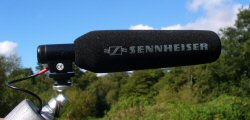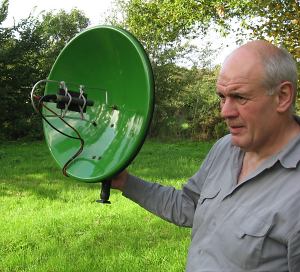Microphones
The microphone is your first point of contact with the sound, and it is a false economy to skimp on this vital part of the system. You will usually get better results with a good microphone and mediocre recorder than with a mediocre mic and a good recorder. Microphones tend to last a long time and are a mature technology, so your investment will not become obsolete or wear out quickly. If you have very limited funds and have a modicum of skill with a soldering iron you can consider making this DIY microphone.
With these models which a beginner can get reasonable results without spending a lot of money. You can listen to some recordings made using some of these mics by a recordist who is a relative newcomer, so you can hear what sort of results you'll get. For the application of someone recording birds at a distance, you first need to choose between a shotgun mic and parabolic dish. The dish gives you the greatest range, but is bulky and awkward to use in the field. The shotgun mic is more handy in the field, and is probably the first choice for a beginner.
All of these are self-powered, i.e. they have an internal battery and are not powered from the recorder via the microphone cable. (You can read more about the powering options for microphones - self-powering is the right choice for a MD recorder). They can all be used with a HiMD recorder and headphones to put together a complete recording system, you need nothing more. They are mono mics, which is common when recording single species which is the approach most newcomers to bird recording tend to start with.
shotgun mics
Note that if your aim is to use your mic with a parabolic dish, then most shotgun mics are not suitable, as they will only receive sound from part of the dish. You would need another microphone to use with the dish. However, the ATR55 can be used with a dish because if offers a choice of shotgun and cardioid responses. The ME66 is not suited to a dish, but the ME62 from the series can be used with the same K6 powering module which you need for the ME66.
audio-technica ATR55

The lowest cost mic I have tried with any success is the ATR55, a mono microphone designed for use with video cameras. There are a number of no-name far-Eastern clones of this model also with the "telemic" label. This is powered by a 1.5V AA battery, and the power switch selects between a cardioid response and somewhat more directional response[1]. This choice is a useful option if you also wish to use the mic in a parabolic dish, for which the cardioid response is better suited. Because of its internal construction, this mic does tend to suffer more than the others from handling noise, so you will find it easier to use this from a fixed support such as a tripod, which reduces handling noise for any microphone.
This mic typically retails at £70[2]

Sennheiser MKE300
Sennheiser MKE300
Another mono microphone designed for use with video cameras. This is powered by a 1.5V LR44 button cell and is quite compact though more directional than the ATR55. It is much less susceptible to handling noise
This mic typically retails at £130[2]
Sennheiser ME66

Sennheiser ME66
This is part of the K6 modular system, and you need the Sennheiser K6 powering module to make this do anything, which is something to watch when pricing this up. It is an excellent choice, delivering a very good sensitivity and low self-noise. It is a common microphone used by birdsong researchers. Many WSRS members use mics from the K6 series, including this one.
With the K6 powering module this mic tends to retail at about £270[2]. For use with a minidisc recorder you should make sure you get the K6 and not the K6P powering module, as minidisc recorders do not provide 48V phantom power.

parabolic dish showing the microphone mounting
Parabolic dish
The parabolic dish is a system - comprising a microphone and a sound reflecting parabolic dish. The dish needs to be at least 50cm in diameter, for practical use. The microphone needs to pick up sounds from the whole surface of the dish, which is why using a very directional mic like a shotgun mic is not recommended. A cardioid microphone, which picks up sound mainly from the front, is often recommended, though you can also use an omni directional microphone. The mic is mounted pointing towards the dish and away from the sound source, and the dish is aimed at the sound source.
You can purchase parabolic dishes commercially - the Amberwood reflector can be used with your own mic, Otherwise you will need to use some ingenuity - there is nothing wrong in using a (solid) centre-fed satellite dish but you will find it heavy to use in the field!!! Most commercial dishes are made of a type of plastic to make the weight manageable.
Telinga manufacture a range of parabolic microphone systems commercially, although the cost of over £800 is a bit more than many people wish to spend at the beginning.
There are, of course, better microphones than those listed here and you can spend a lot more. Compare a more expensive mic with a cheaper one and usually the difference is that the sound is clearer, and often you will get a lower noise level. However, with any of these you will be able to get out in the field and make recordings, which is the best way to hone your skills and increase your appreciation of the the sounds of the natural world.
Unless you limit yourself to recording on windless days you will also need some form of wind protection which I deal with next. You will have difficulty recording outdoors using only the foam windshield provided by the mic manufacturer.
next - Wind protection- The technically curious will find this is achived by having two electret capsules, the cardioid at the front of the mic and the hypercardioid a little bit further back, so the interference tube (the slots you see) attenuates sound coming from the side. On Tele setting, some 10dB of audio gain is also added
- 2006 prices, including VAT